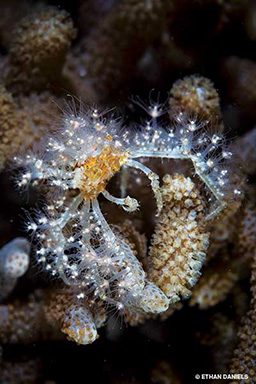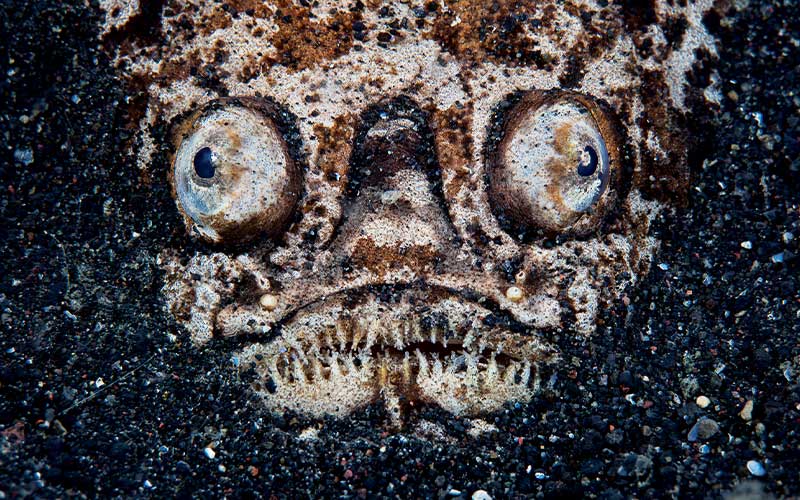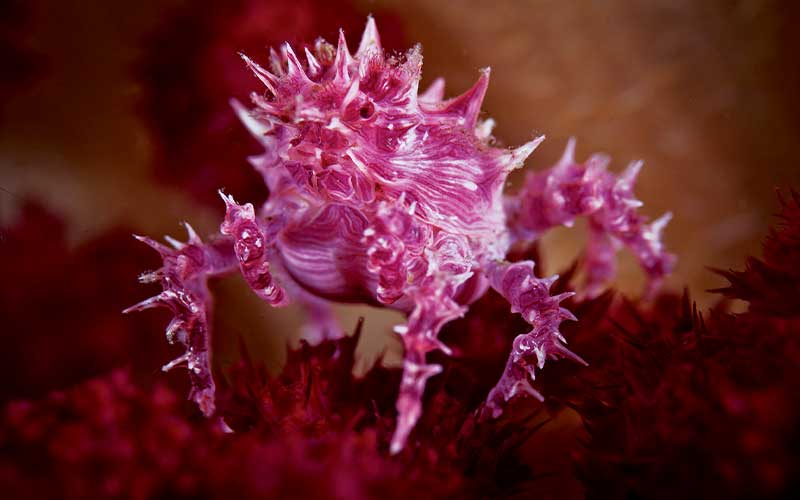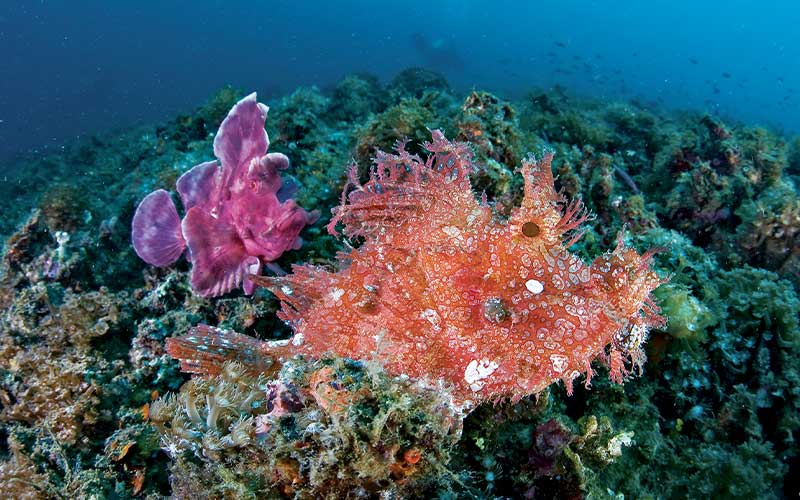Just about anyone who pores through copies of Alert Diver recognizes that there is often much more than meets the eye in the minutiae of a coral reef, kelp forest, shipwreck or slope of dark sand. The vast sweep of submerged nature in 360 degrees tends to be crammed with an almost unbelievable variety of niches and life, consistently amazing those who seek the mysteries beneath the waterline.

While wide-angle views of underwater scenery are often breathtaking, they never tell a habitat’s whole story. Concealed among the dark recesses and shadows, or even sitting in plain sight but practically impossible to see, are an inordinate number of creatures that play significant roles in their food webs but have evolved to visually disappear into their environment.
The sea is bursting with creatures using clever visual tricks to fool other creatures in a high-stakes game of life and death. Over time, natural selection has led to incredible examples of blending in, tricked-out patterns, shrewd disguises and deceitful mimicry. In many cases image capture allows us to pull back the curtain to reveal the splendid creativity of the hidden.
How to generate aesthetic images of effectively veiled creatures is one of the eternal quandaries that underwater photographers face. There are loads of ways (and opinions about how) to photograph camouflaged marine life; this article is intended to offer straightforward photographic ideas, techniques and insights into a few of those methods. As always, take what you can from what you read and from other photographers’ advice, and use your own ingenuity to build upon it.
Do Your Homework
Diving is an easy means of exploring a foreign world; to investigate and photograph that world fruitfully, assess the type of habitat you’re about to enter before you don your dive gear. When your objective is to photograph organisms that would rather go unnoticed, knowing a little about what to expect in the local environment should improve your ability to find them. Research what critters exist in the area, and learn which ones are common and which are rare. Ascertain what niches or microhabitats the critters have affinities for.
Camouflaged animals come in all shapes and sizes, so you’ll have to decide whether to dive with a macro or a wide-angle lens. Other pieces of gear to consider include snoots, external slave strobes and diopters. Knowing both the habitat and the range of expected marine life will undoubtedly enhance the productivity of your image-making.
Focus
I am a proponent of keeping one’s photographic goals relatively simple and staying focused on them. Overextending yourself underwater — attempting to shoot everything you see — is the best way to accumulate a bunch of mediocre images; your imaging goals should be loftier than acquiring a series of run-of-the-mill photos.

You assess the habitat, set off and cruise unhurriedly above the sea floor, your eyes sweeping across the seascape and scanning for anything that doesn’t quite fit in — just like the numerous search-imaging predators that camouflaged prey have evolved to avoid over millions of years. (Predators develop a search image based on clues about the prey they encounter most frequently, often overlooking rare prey types.) You spy eyes, a pattern or the outline of something indistinct amid the overgrown reef, and adrenaline percolates into your bloodstream, quickening your pulse. The thrill of the hunt and of the opportunity at hand is upon you. This is an instant in which critical photographic decisions are made. How will you depict an animal that is, for all practical purposes, nearly invisible?
Present Your Subject
Whether to set apart your subject from its background or incorporate the surroundings (thereby highlighting the animal’s ability to blend in) is one of the first dilemmas to resolve. Though it’s often difficult to situate yourself amid the bottom cover and topography, photographing the subject from a low vantage point will assist in detaching the animal from the background. Shooting from a higher angle, on the other hand, will bring the immediate background into the image. Try both of these approaches since you never know until postprocessing which setting will achieve the highest approval ratings from viewers.

Shine a Light
One basic and easy to construct piece of equipment that all photographers should have in their gear arsenal is a snoot. A snoot funnels light from your strobe(s); it’s basically the yang to the diffuser’s yin. As a controlled spotlight, a snoot can separate the subject from the confusing or clutter-filled background in which it lies, regardless of the vantage point.
To highlight the texture of a creature’s details, such as the haggard mug of a scorpionfish, you might choose to use “monster lighting.” This rarely used method of
illumination will emphasize elevated features and create dark shadows behind any topography on the subject, giving the image a creepy feel. Place one strobe in front of but at an extreme upward angle toward the subject. Turn off the other strobe. (The effect is the same as when you hold a flashlight under your chin to tell ghost stories.) It only works for subjects with rugged profiles. Rembrandt-style lighting, in which one angled strobe is strong while another strobe is used for fill lighting, is also effective at creating dramatic shadows and highlights on marine life. Experiment with using strobes at different output settings, and work with them in manual mode.
Side lighting, with strobes pointed at right angles (or nearly so) to the lens, will facilitate capture of a subject’s scaly, filamentous or undulating surface. If you feel like getting fancy, especially with critters that have filaments, skin flaps or distinctive outlines, backlighting is a powerful, if sometimes difficult, method for creating a noteworthy image. Backlighting requires a light source behind the subject that’s pointed directly at the lens. It takes patience, but backlighting can produce award-winning images because it provides unusual perspectives of camouflaged critters.
Draw the Eye
Some of the most eye-catching macro images of disguised marine beasts are photographed using a small depth of field (DOF). By opening the aperture (to f/5.6, f/4 or wider), you will limit the sharpness of the final image while accentuating critical aspects of the subject (such as a flounder’s eyes, a nudibranch’s rhinophore or a lizardfish’s teeth) while de-emphasizing the foreground and background. Yet another valuable method of producing a memorable image of a minute, secreted creature is to provide scale by incorporating a nearby coral polyp or similarly familiar aspect of the environment — without using an introduced object such as a coin or a finger.

Show Motion
Capturing movement or behavior of camouflaged creatures requires great patience, but it can be highly rewarding. An image of a lumpy-looking frogfish’s yawn or a flattened flounder’s fluttering motion gives viewers a glimpse of a rarely seen moment in the animal’s life. While waiting for a fish or invertebrate to do something — anything — be certain to have its eyes in sharp focus. Motion is difficult to photograph, so use negative space to give the subject room to move in your composition. Try to predict what will happen (feeding or spawning, for example).
Go Big or Go Small
While most photographers focus on camouflaged marine creatures that are on the smaller side, needing macro lenses such as a 60mm or 100mm, plenty of beasts out there — such as tasselled wobbegongs, adult broadclub cuttlefish, giant frogfish and larger octopuses — require wide-angle or fisheye lenses. Though you may use a completely different lens, such as a fisheye, to shoot them, the same techniques used for smaller disguised creatures still apply.

I hope this article gives you some new ideas or reminds you of an old, time-tested method you once knew. Make it your habit to try a variety of different photographic techniques, especially with critters that so often go unseen. Plan your dives with regard to the types of lighting you will be using, but try to remain flexible. As every diver knows, Mother Nature is fickle. Shoot at unusual angles, use unusual lighting to highlight unusual features, and utilize different shutter speeds and apertures. But mostly remember to admire what you’re witnessing — Mother Nature at her most creative. Many wondrous adaptations, including blending, patterns, disguises and mimicry, are especially common underwater because aquatic predators have evolved to use highly efficient search imaging. Keep in mind that evolution is always in play, perfecting species within their habitats; as search-imaging predators get better at what they do, they weed out prey that are not quite as well adapted to the environment.
So remember to be amazed at the seemingly endless variety of forms that life takes. It is far from easy to throw light on cryptic, camouflaged animals and create great images. But for some reason we divers are drawn to hunt and photograph these creatures, which may be more grotesque or misleading in appearance than they are beautiful or graceful. Whether the reasons for this attraction are related to the emotions of privilege and wonder or based in the desire to marvel at nature’s adaptations shaped over time and under pressure, photography of the unseen is a challenge and a test of your photographic creativity. It’s also just good old fun.
© Alert Diver — Q3 Summer 2014